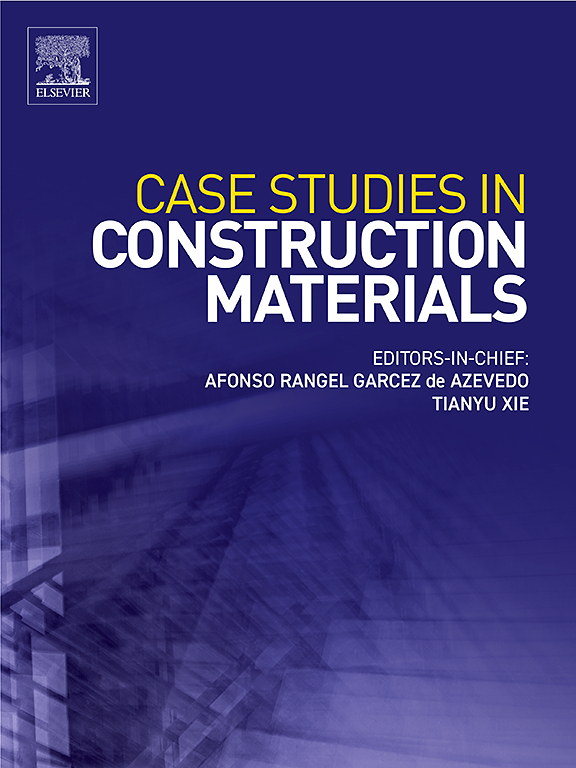BFRP抗浮锚杆的锚固性能:现场调查与数值模拟
IF 6.6
2区 工程技术
Q1 CONSTRUCTION & BUILDING TECHNOLOGY
引用次数: 0
摘要
玄武岩纤维增强聚合物(BFRP)锚杆具有重量轻、抗拉强度高、耐腐蚀性好等优点,是地下结构中钢锚杆的理想替代品。本研究通过对3根直径为25 mm的全螺纹BFRP锚杆进行拉拔试验,并利用ABAQUS有限元软件进行分析,研究其锚固性能及破坏机理。试验结果表明,BFRP抗浮锚杆的抗拔能力超过400 kN,满足工程设计抗浮要求。锚杆轴向应力在孔口处最大,随深度增加而迅速减小。轴向应力传递深度约为2 L/3 (L为锚杆锚固长度)。剪切应力沿锚固深度开始迅速增大,在锚固深度0.75 m附近达到峰值,之后逐渐减小,随着荷载水平的增加,峰值剪应力逐渐增大。数值模拟结果表明,拉拔过程中锚杆与锚固体之间的黏结强度存在多个分量,且随着荷载的增大,荷载从开孔处向下传递,而不是在整个锚固长度上均匀分布。锚杆直径相同,锚固长度越长,轴向应力衰减速率越慢,轴向应力传递范围越大。失效分析确定了三种失效机制。第一界面剪切滑移破坏是由于第一界面的摩擦力、机械咬合力和化学黏结力在载荷增大下减小所致;第二界面的剪切滑移破坏是由于岩土体强度不足造成的。锚杆断裂是由纤维束局部应力集中引起的进行性断裂引起的。本文章由计算机程序翻译,如有差异,请以英文原文为准。
Anchorage performance of BFRP anti-floating anchors: Field investigation and numerical simulation
Basalt Fiber Reinforced Polymer (BFRP) anchor bars offer several advantages including light weight, high tensile strength and good corrosion resistance, making them an ideal alternative to steel anchor bars in underground structures. This study through the pullout test of three 25 mm diameter fully threaded BFRP anchor bars and analysis using ABAQUS finite element software to investigate their anchorage performance and failure mechanisms. The experiment shows that the pullout capacity of BFRP anti-floating anchors exceed 400 kN, which meets the engineering design requirements for anti-floating. The axial stress of anchor bar is highest at the opening of hole and decreases rapidly with increasing depth. The depth of the axial stress transmission is approximately 2 L/3 (L is the anchorage length of the anchor bar). The shear stress initially increases rapidly along the anchorage depth, peaks near an anchorage depth of 0.75 m, and gradually decreases thereafter, with the peak shear stress increasing with higher load levels. The numerical simulation indicates that the bonding strength between the anchor bar and anchorage body multiple components during the pullout process, with the load transferring downwards from the opening-hole as the load increases, rather than being uniformly distributed throughout the entire anchorage length. Anchor bars with longer anchorage lengths exhibit a slower decay rate of axial stress and a deeper range of axial stress transfer, despite having the same diameter. The failure analysis has identified three failure mechanisms. The shear slip failure at the first interface is caused by a decrease in frictional force, mechanical bite force, and chemical adhesive force at the first interface under increasing load; the shear slip failure at the second interface is due to insufficient strength of the rock-soil mass. Anchor bar fracture failure originates from progressive fracture caused by localized stress concentration in the fiber bundles.
求助全文
通过发布文献求助,成功后即可免费获取论文全文。
去求助
来源期刊

Case Studies in Construction Materials
Multiple-
CiteScore
7.60
自引率
19.40%
发文量
842
审稿时长
63 days
期刊介绍:
Case Studies in Construction Materials provides a forum for the rapid publication of short, structured Case Studies on construction materials. In addition, the journal also publishes related Short Communications, Full length research article and Comprehensive review papers (by invitation).
The journal will provide an essential compendium of case studies for practicing engineers, designers, researchers and other practitioners who are interested in all aspects construction materials. The journal will publish new and novel case studies, but will also provide a forum for the publication of high quality descriptions of classic construction material problems and solutions.
 求助内容:
求助内容: 应助结果提醒方式:
应助结果提醒方式:


